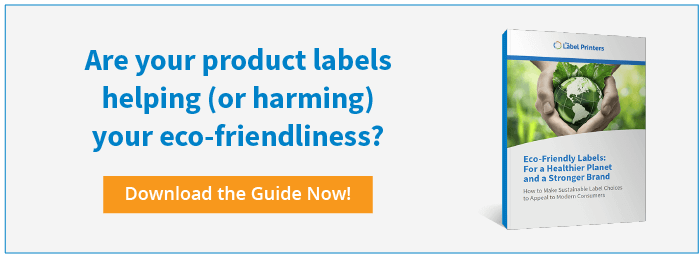
Can something as small as a product label make a significant impact in the face of the climate crisis? And if so, can switching to eco-friendly labels also benefit your business?
The answer to both questions is yes. In this article, we’ll lay out the environmental and business cases for eco-friendly labels, to show you that what’s good for the planet can be great for your brand … and your bottom line.
What Makes a Label Eco-Friendly?
Before we get into the benefits of eco-friendly labels, let’s clarify what we mean by “eco-friendly.” There are several ways to limit a product label’s environmental impact:
- Reduce the label size. Smaller labels use fewer resources. (Just be sure your label is still legible and contains enough space to print all your regulatory requirements.)
- Choose sustainable materials. Sustainable label materials include FSC-certified paper, compostable face stocks and adhesives, recycled paper or film, and biodegradable plastic made from polylactic acid (PLA).
- User thinner or recyclable liners. Silicone-coated label liners are not recyclable with conventional methods. However, your label printer may collect used liners to ship them to a specialized recycler. Also, consider using PCR PET liners or thinner liners—which consume less energy and fewer resources—or linerless labels.
Another way to think about eco-friendly labels is in terms of a circular economy. In a circular economy, little goes to waste; products and materials are kept in use as long as possible, allowing natural resources to regenerate.
Reusability is the gold standard of the circular economy. So, encourage the reuse of your product packaging, either by making your label as durable and attractive as possible, or by making your label reasonably easy to remove. (The right label adhesive is key to this, so choose a label vendor who knows their stuff.)
Related Reading: Eco-Friendly Labels: For a Healthier Planet and a Stronger Brand
Why It’s Important to Choose Eco-Friendly Labels
Any of the eco-friendly label options discussed above (and others your label printer might suggest) can help your company achieve its sustainability goals. Here’s why:
Product Packaging Creates a LOT of Waste
According to the most recent information from the U.S. Environmental Protection Agency, containers and packaging make up over 28% of total municipal solid waste in America. Only a little more than half of that gets recycled.
The rest ends up in landfills, or worse, polluting the nation’s open spaces and water.
Worldwide, nearly 20% of all single-use product packaging leaks into the environment (according to a 2020 McKinsey report), often making its way to the ocean, where plastic pollution accumulates into massive blobs like the Great Pacific Garbage Patch. Only about 14% to 18% of plastic waste is recycled globally.
Due to their sheer size, product labels contribute less to global packaging pollution than containers, wraps and boxes. Nevertheless, labels are common packaging elements, and they must be accounted for in any sustainable packaging initiative.
Some Paper Labels Contribute to Deforestation
Just because paper is a “natural” material, it doesn’t mean that paper labels are any more eco-friendly than plastic labels.
The world’s forests are disappearing at an alarming rate, endangering countless species and fueling climate change. The pulp and paper industry uses up to 40% of all industrial wood traded globally.
While a tiny paper label doesn’t seem consequential, consider how many product and shipping labels get printed on virgin materials over the course of the average year. The more we can transition to recycled materials the more we reduce the strain on our forests.
The Wrong Product Labels Can Make Product Packaging Less Recyclable
Your company has invested too much in recyclable product packaging to let your product label diminish its recyclability. Unfortunately, product labels can be rejected by local Material Recovery Facility (MRF) or gum up recycling equipment and reduce the recycled material’s value—especially when there is a mismatch between the label and packaging materials.
Recycling facilities expect a certain amount of contamination, and most labels and label adhesives are burned off or washed off during the recycling process. But the impurities can accumulate over time.
To guarantee the maximum recyclability of your product packaging, encourage your customers to remove your labels before recycling or ask your label printer about label technology designed to separate cleanly during the recycling process.
How Eco-Friendly Labels Help Your Business
Sustainable product labels are good for your company’s bottom line. If the people holding the purse strings in your organization need convincing, share these facts with them:
Most Young Consumers Would Pay a Premium for Sustainable Products
As Gen Z and millennial dominance grows, sustainable packaging and eco-friendly labels will soon become table stakes when it comes to attracting and retaining new customers.
Once seen as the future of shopping, millennials and the members of Generation Z are now the driving forces defining consumer behavior across America. More so than previous generations, these younger groups expect brands to reflect their personal values, and they can be fiercely loyal to brands that do.
Sustainability is chief among the values millennials and Gen Zers espouse. In a 2021 Deloitte survey, Gen Zers ranked “climate change/protecting the environment” as their top concern. The environment ranks third among millennial priorities, but it is essentially tied with the more immediate concerns of health and employment.
When it comes to sustainability, millennials and Gen Zers are willing to put their money where their mouths are. According to a First Insight survey, 62% of both groups say they prefer to buy from sustainable brands, and a majority of each group says they would be willing to spend more than 10% for sustainable products.
Going Green Saves Your Business Money
The circular economy is all about doing the most with what you have. In business, doing the most with what you have is known by another word: efficiency. Big companies like Nestle and Nike have discovered that sustainable choices help them maximize resources and energy, letting them stretch their budgets further.
As you look to find cost savings for your business through efficiency improvements, consider your labels. There are many ways to save energy and reduce waste throughout the label design and production process.
Every little bit counts, from the fuel consumed transporting your labels (which can be reduced by consolidating shipments) to the paper used to share design drafts (which can be replaced by digital documents). Be sure to talk to your label printer to discover other ways to go lean and green.
Government Programs Incentivize Sustainability
Why leave free money on the table? Federal and state government agencies may offer grants, tax incentives, and loans for companies willing to make eco-friendly improvements.
The U.S. Small Business Administration offers a helpful resource for finding environmental grants and loans from several federal entities. Find state incentives using the Database of State Incentives for Renewables & Efficiency built by North Carolina State University.
Sustainable choices, including eco-friendly labels, may also help your business win government contracts under the U.S. General Services Administration’s Green Purchasing Plan.
Your Complete Guide to Buying Eco-Friendly Labels
As we’ve established, there are ample business and environmental reasons to choose eco-friendly labels. So, where can you purchase eco-friendly labels? And which sustainable label options will perform best for your application?
Find your answers in the web’s most comprehensive guide to buying sustainable labels, “Eco-Friendly Labels: For a Healthier Planet and a Stronger Brand.”

